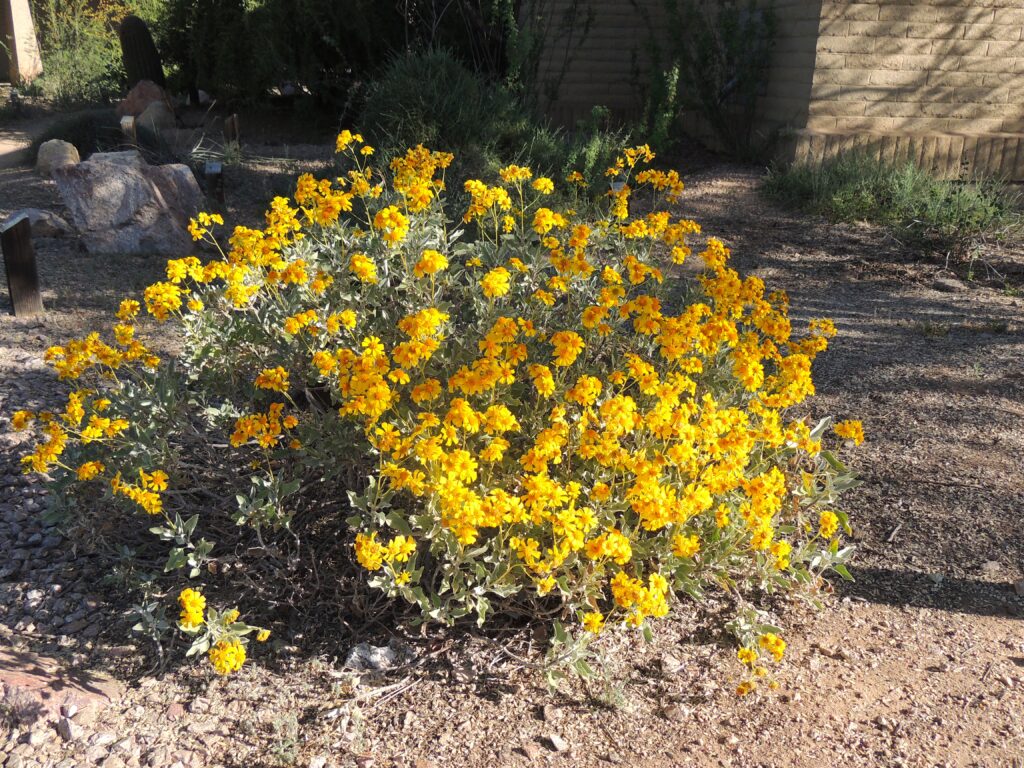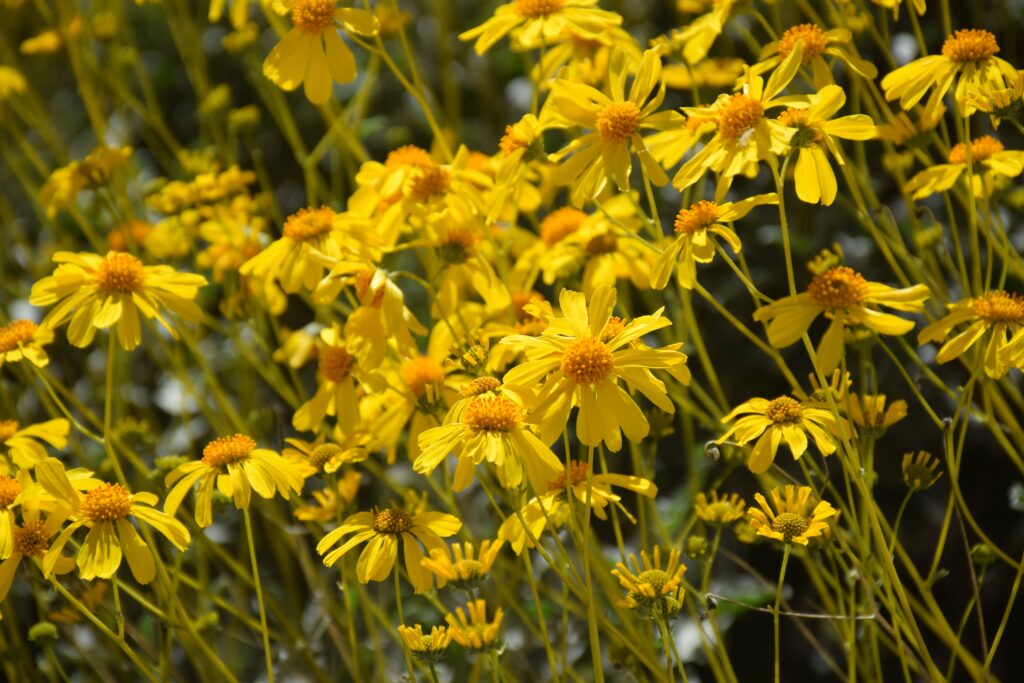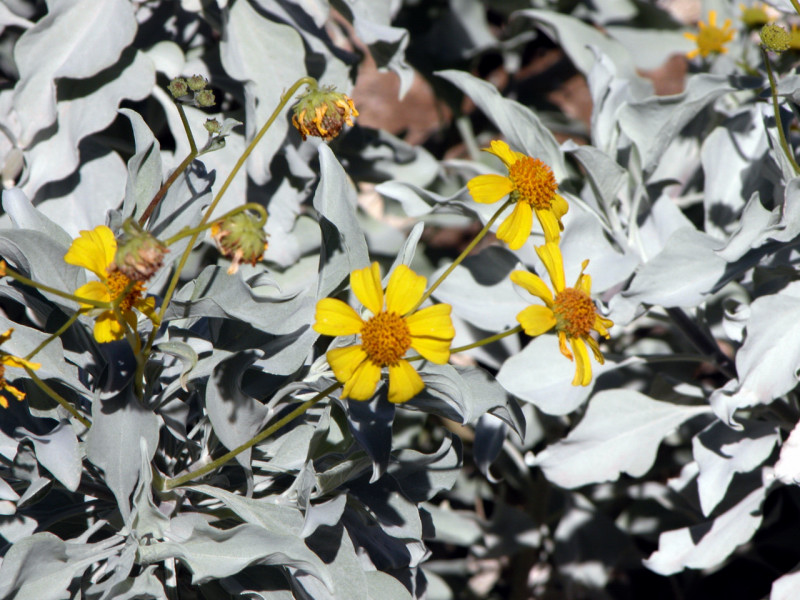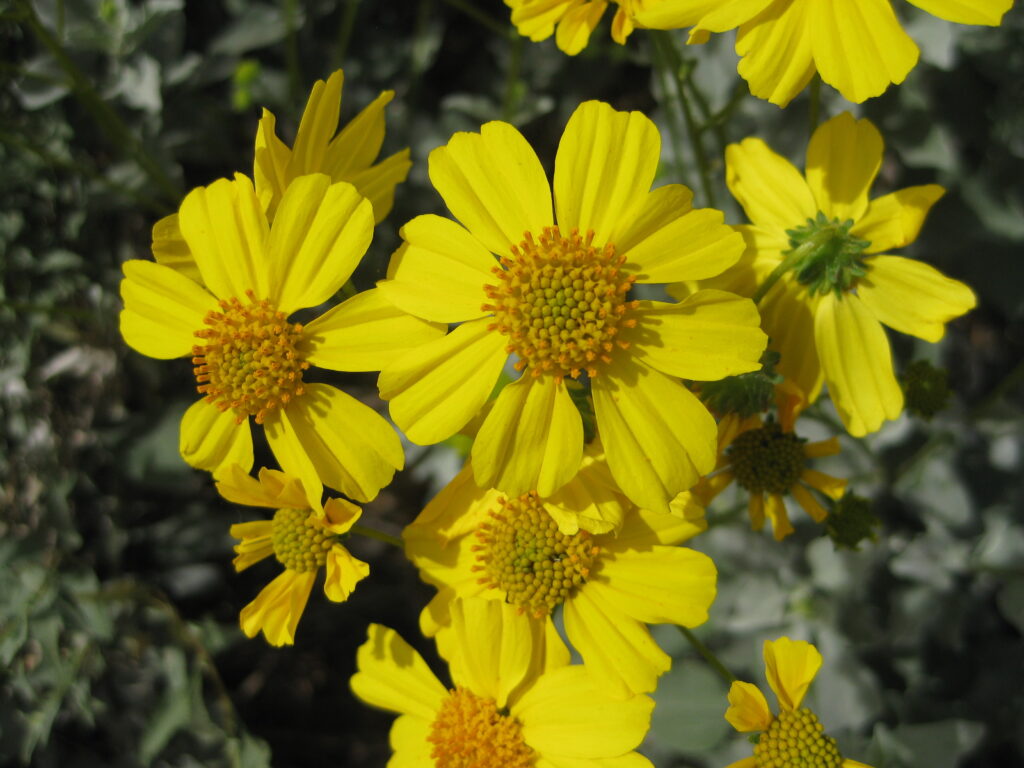This month, our plant of the month blog features another plant description from a newly revised book, Cool Plants for Hot Gardens by Greg Starr! In his book, Greg features 150 water-smart choices for the Southwest – it’s no wonder why we like the book so much here at Water – Use It Wisely! He includes a fun category of the “Etymology” or the origin of the scientific name, as well as “Field Notes” he has taken (and somehow kept track of) that describe where he found or has observed the plants growing in habitat.
Brittlebrush, Encelia farinosa
AT-A-GLANCE

Attracts bees, butterflies.
|
Etymology
Asa Gray chose the Latin farin- to describe the white glaucous bloom on the leaves.
Field Notes
When there is enough winter rain, the Sonoran Desert explodes with color as Encelia farinosa comes alive with bright yellow flowers standing high above the silvery gray foliage. I frequently see these colorful shrub-like plants scattered among large boulders on rocky hills in the Tucson Mountains. After a good winter rainy season, I like to see the yellow flowers set against the black rock hills along Interstate 10 in western Arizona. The distribution is widespread from southern California and southern Nevada, south to Arizona, Baja California, and northwestern Mexico from near sea level up to 4,275 feet.
Description
These tough, shrub-like perennials form hemispherical mounds of silvery gray foliage that will die down in summer if not watered. Stems are mostly herbaceous although they can become slightly woody near the base. Leaves will hold on for dear life through winter unless temperatures get too cold or lack of rainfall forces them to flee. The silvery gray mounds are blanketed by long stalks with bright yellow, daisy-like flowers. Flowers are bee and butterfly magnets and occur primarily in spring, although they can start blooming as early as October.

Culture
Established plants are top hardy if the winter lows stay above the mid-20’s F range and are considered hardy in USDA zones 9b-11. Stems may freeze to the ground when temperatures drop below mid-20’s F. The growth rate is fast, and frost damaged plants will recover quickly when the temperature warms enough in spring. Place these in full sun or reflected heat to ensure best flowering and maximum winter warmth. The soil should have excellent drainage. Although plants are naturally adapted to go dormant in late spring and early summer prior to monsoon season, they will respond to supplemental water in summer. Prune out any frost damaged stems in late winter.
Identification

The relatively large silvery gray leaves, hemispherical shape, and bright yellow daisy-like flowers set this apart from any other Encelia species.
Landscape Application
Brittlebush needs sun and warmth for the most compact shape and maximum flowering. Plants make an excellent color accent in most any low-water-use landscape, attracting butterflies and bees when in bloom. Mass several plants to provide exceptional color and mix with large accent plants to carry the area if the Brittlebush dies down. Plant among a grouping of the green Agave gentryi, the spiky Fouquieria splendens, the tall Nolina nelsonii or the stately Yucca elata. Mix in some spring or summer flowering plants such as Glandularia gooddingii, Justicia californica, Leucophyllum laevigatum, Penstemon parryi, or Salvia greggii.
Precautions
Protect young plants from rabbits as they are likely to test out the palatability. Mature plants surviving on natural rainfall ought to be left alone by the cute four-legged creatures.
~ ~ ~ ~ ~ ~ ~ ~ ~ ~ ~ ~ ~ ~ ~ ~ ~ ~ ~ ~ ~ ~ ~ ~ ~
Did you know that up to 70 percent of water use is outdoors? That’s why we love desert plants and feature them each month. It’s still a great time to plant non-tropical plants in your landscape, and you can learn more about Brittlebush and other plants on our Arizona Low-Water-Use Plants page. Visit our page on Choosing and Planting Low Water-Use Plants for tips on plant selection and how to plant properly. Also, be sure to read through all of our featured Plant of the Month blogs!
Water – Use It Wisely is proud to feature guest bloggers who write about topics related to water and water conservation. Greg Starr is a horticulturist and the owner/manager of Starr Nursery located in Tucson, AZ. It is a mail order nursery where you can shop online. Greg has traveled extensively in Mexico and the southwestern United States to study native plants for their potential landscape use in desert regions of the world. In 2009, Greg entered the world of literature as an author with the publication Cool Plants for Hot Gardens. This book was revamped and revised in its second edition published in December of 2021. The book is available online.
Header photo taken by Kirti Mathura.


